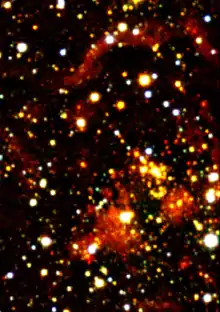Westerhout 49
In astronomy Westerhout 49 also known as W49, is a strong galactic thermal radio source characteristic of an HII region. It was discovered by Gart Westerhout in 1958.
| Emission nebula | |
|---|---|
| H II region | |
 UKIDSS JHK image of W49 | |
| Observation data: J2000.0 epoch | |
| Right ascension | 19h 10m 17s |
| Declination | +09° 06′ 00″ |
| Constellation | Aquila |
| Designations | W49, Westerhout 49 |
Its distance is estimated to be about 11.1 kpcs or 36,000 light years.[1] and it lies in the galactic plane about the same distance from the galactic centre as does the Sun. It has been compared to the giant HII region NGC 3603 which is about half as distant. Non-thermal radiation has been found which is believed to be from an old supernova remnant. Gaseous molecular outflows have been detected as well as H2O (water) masers . No optical counterpart has yet been discovered. While this is partly due to interstellar absorption, any tight clustering of stars at such a great distance in the galactic plane would be scarcely distinguishable from the general background.
A study published in 2014, where the VLT has been used among other instruments, shows the presence of a very massive star in the central cluster of this star-forming region. The parameters of said star (W49nr1) are so far poorly constrained, but a luminosity of several million times that of the Sun is estimated as well as an initial mass between 100 and 180 solar masses, and perhaps even more, what would place it among both the most luminous and massive stars known.[2]
References
- "Uncloaking the King of the Milky Way: The largest star in our home galaxy's largest stellar nursery". www.nanowerk.com. Retrieved 2016-01-12.
- Wu, S. W.; Bik, A; Henning, T. H.; Pasquali, A.; Brandner, W.; Stolte, A. (2014). "The discovery of a very massive star in W49". Astronomy & Astrophysics. 568. arXiv:1407.4804. Bibcode:2014A&A...568L..13W. doi:10.1051/0004-6361/201424154.
- A Survey of the Continuous Radiation from the Galactic System at a Frequency of 1390 Mc/s, G. Westerhout, Bull. Astron. Inst. Neth.14, 215, 1958.
- A Distant HII Region in the Galaxy, K. Akabane and F. J. Kerr (Frank John Kerr), Aust. J. Phys. 18, 91, 1965.
- Galactic HII Regions. The nature of the Radio Source W49, P. G. Mezger and J. Schraml, Astropys. J.150, 807,1967.
- High Resolution Observations of the Radio Source W49, C. G. Wynn-Williams, Mon. Not. R. astr. Soc. 142, 453 1969.
- High Resolution Far-infrared Observations of HII Regions: Sagittarius B2, W49, DR 21- W75, P. M. Harvey, M. F. Campbell and W. F. Hoffman, Astrophys. J. 211, 786, 1977.
